Financial Performance Analysis of Amcor Limited and Competitor
VerifiedAdded on 2021/05/31
|7
|1430
|87
Report
AI Summary
This report presents a comprehensive financial analysis of Amcor Limited, a global leader in packaging, and compares its performance with its competitor, Bemis Company. The analysis includes a detailed examination of profitability ratios such as gross profit, operating profit, and net profit, revealing Amcor's improved profitability in 2017 compared to 2016, while Bemis experienced a decline. The report further dissects Amcor's cash flow statement, categorizing cash flows into operating, investing, and financing activities, highlighting the company's positive cash generation from these activities. Finally, the analysis assesses Amcor's balance sheet, noting the company's current asset and liability positions, and its debt-to-equity ratio, suggesting potential financial leverage and the need for strategic financial planning to maintain a sustainable capital structure. The report concludes with references to relevant sources. This assignment is contributed by a student to be published on the website Desklib.

Running head: ACCOUNTING FOR BUSINESS
Accounting for business
Name of the student
Name of the university
Student ID
Author note
Accounting for business
Name of the student
Name of the university
Student ID
Author note
Paraphrase This Document
Need a fresh take? Get an instant paraphrase of this document with our AI Paraphraser
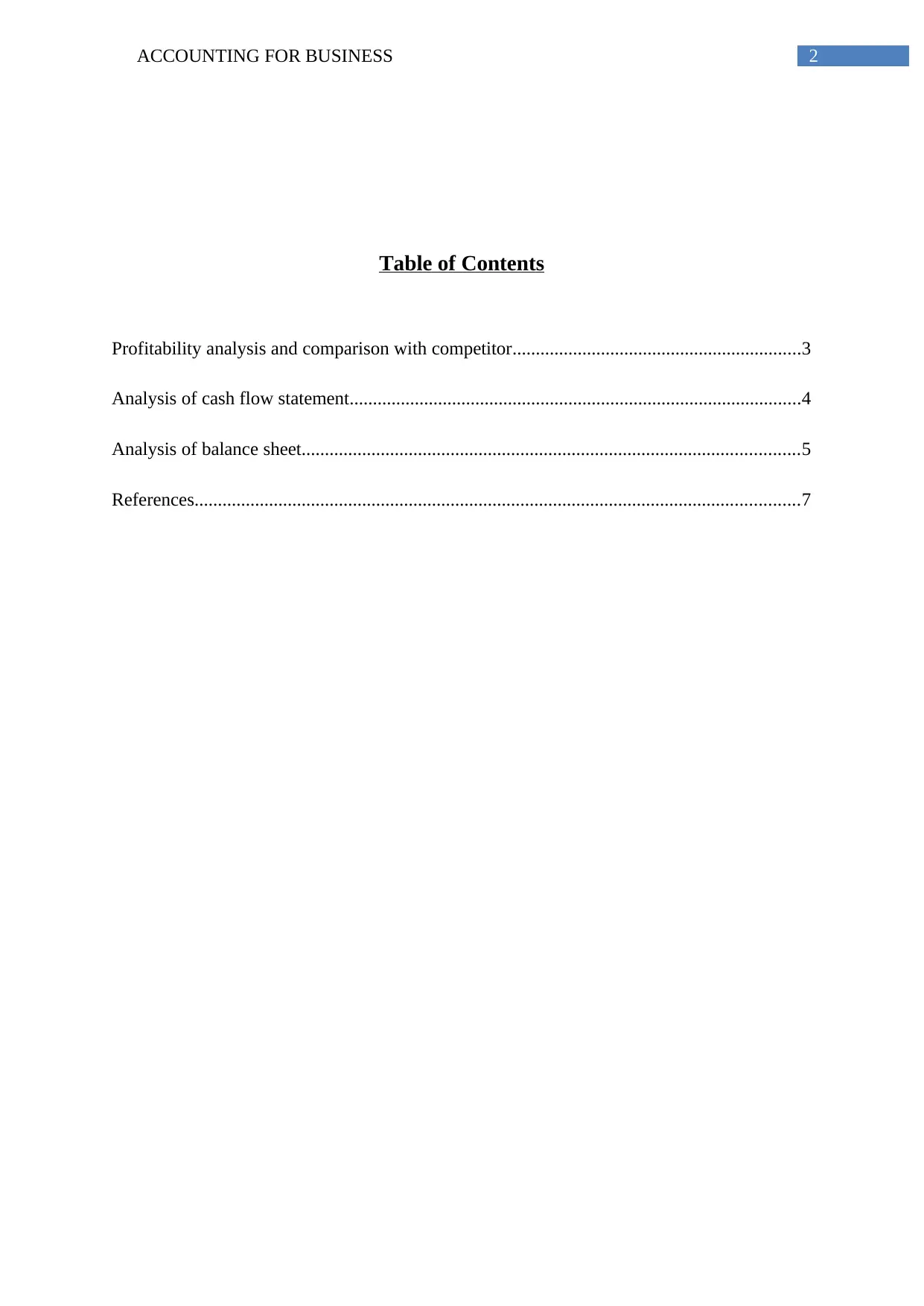
2ACCOUNTING FOR BUSINESS
Table of Contents
Profitability analysis and comparison with competitor..............................................................3
Analysis of cash flow statement.................................................................................................4
Analysis of balance sheet...........................................................................................................5
References..................................................................................................................................7
Table of Contents
Profitability analysis and comparison with competitor..............................................................3
Analysis of cash flow statement.................................................................................................4
Analysis of balance sheet...........................................................................................................5
References..................................................................................................................................7
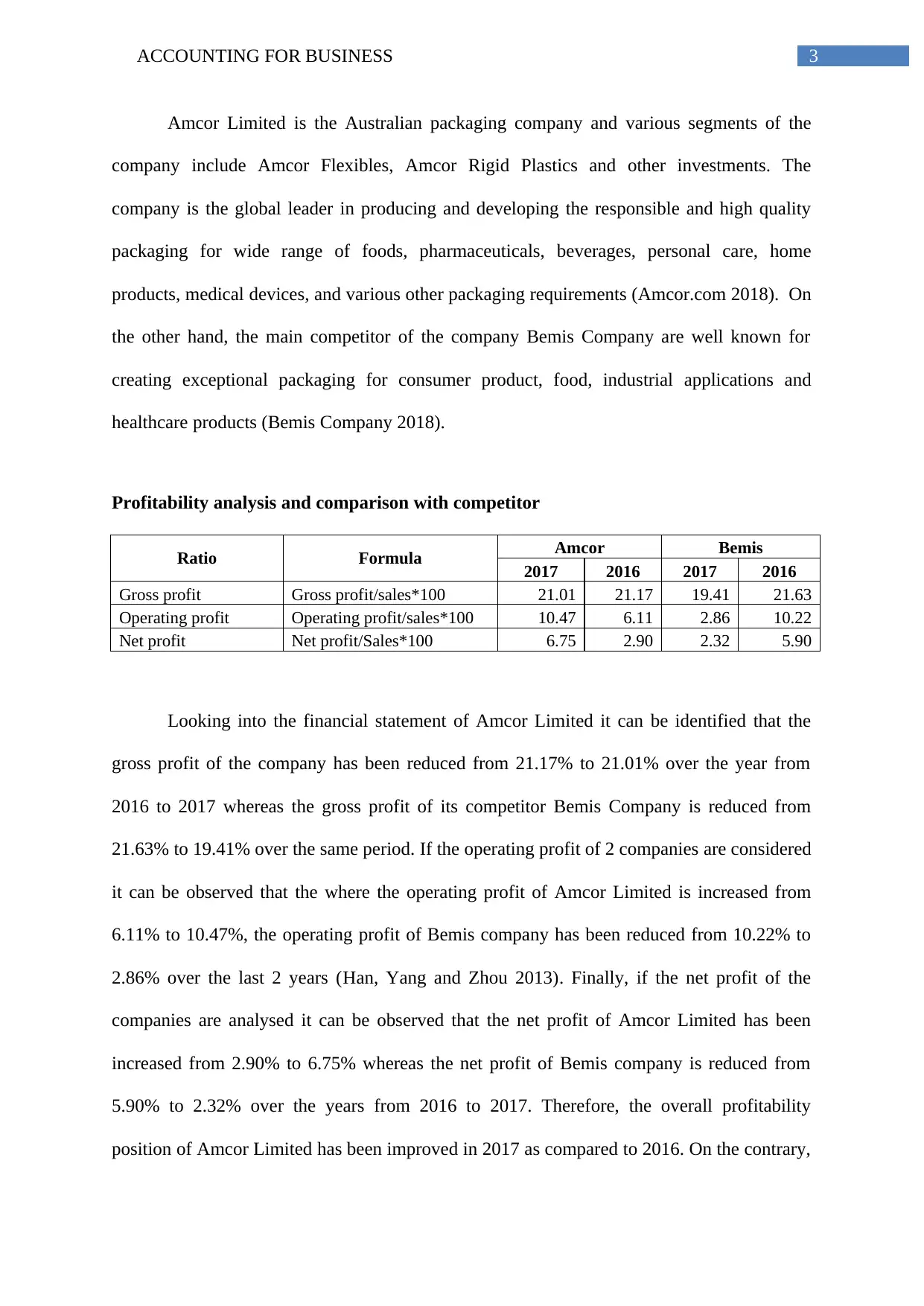
3ACCOUNTING FOR BUSINESS
Amcor Limited is the Australian packaging company and various segments of the
company include Amcor Flexibles, Amcor Rigid Plastics and other investments. The
company is the global leader in producing and developing the responsible and high quality
packaging for wide range of foods, pharmaceuticals, beverages, personal care, home
products, medical devices, and various other packaging requirements (Amcor.com 2018). On
the other hand, the main competitor of the company Bemis Company are well known for
creating exceptional packaging for consumer product, food, industrial applications and
healthcare products (Bemis Company 2018).
Profitability analysis and comparison with competitor
Ratio Formula Amcor Bemis
2017 2016 2017 2016
Gross profit Gross profit/sales*100 21.01 21.17 19.41 21.63
Operating profit Operating profit/sales*100 10.47 6.11 2.86 10.22
Net profit Net profit/Sales*100 6.75 2.90 2.32 5.90
Looking into the financial statement of Amcor Limited it can be identified that the
gross profit of the company has been reduced from 21.17% to 21.01% over the year from
2016 to 2017 whereas the gross profit of its competitor Bemis Company is reduced from
21.63% to 19.41% over the same period. If the operating profit of 2 companies are considered
it can be observed that the where the operating profit of Amcor Limited is increased from
6.11% to 10.47%, the operating profit of Bemis company has been reduced from 10.22% to
2.86% over the last 2 years (Han, Yang and Zhou 2013). Finally, if the net profit of the
companies are analysed it can be observed that the net profit of Amcor Limited has been
increased from 2.90% to 6.75% whereas the net profit of Bemis company is reduced from
5.90% to 2.32% over the years from 2016 to 2017. Therefore, the overall profitability
position of Amcor Limited has been improved in 2017 as compared to 2016. On the contrary,
Amcor Limited is the Australian packaging company and various segments of the
company include Amcor Flexibles, Amcor Rigid Plastics and other investments. The
company is the global leader in producing and developing the responsible and high quality
packaging for wide range of foods, pharmaceuticals, beverages, personal care, home
products, medical devices, and various other packaging requirements (Amcor.com 2018). On
the other hand, the main competitor of the company Bemis Company are well known for
creating exceptional packaging for consumer product, food, industrial applications and
healthcare products (Bemis Company 2018).
Profitability analysis and comparison with competitor
Ratio Formula Amcor Bemis
2017 2016 2017 2016
Gross profit Gross profit/sales*100 21.01 21.17 19.41 21.63
Operating profit Operating profit/sales*100 10.47 6.11 2.86 10.22
Net profit Net profit/Sales*100 6.75 2.90 2.32 5.90
Looking into the financial statement of Amcor Limited it can be identified that the
gross profit of the company has been reduced from 21.17% to 21.01% over the year from
2016 to 2017 whereas the gross profit of its competitor Bemis Company is reduced from
21.63% to 19.41% over the same period. If the operating profit of 2 companies are considered
it can be observed that the where the operating profit of Amcor Limited is increased from
6.11% to 10.47%, the operating profit of Bemis company has been reduced from 10.22% to
2.86% over the last 2 years (Han, Yang and Zhou 2013). Finally, if the net profit of the
companies are analysed it can be observed that the net profit of Amcor Limited has been
increased from 2.90% to 6.75% whereas the net profit of Bemis company is reduced from
5.90% to 2.32% over the years from 2016 to 2017. Therefore, the overall profitability
position of Amcor Limited has been improved in 2017 as compared to 2016. On the contrary,
⊘ This is a preview!⊘
Do you want full access?
Subscribe today to unlock all pages.

Trusted by 1+ million students worldwide
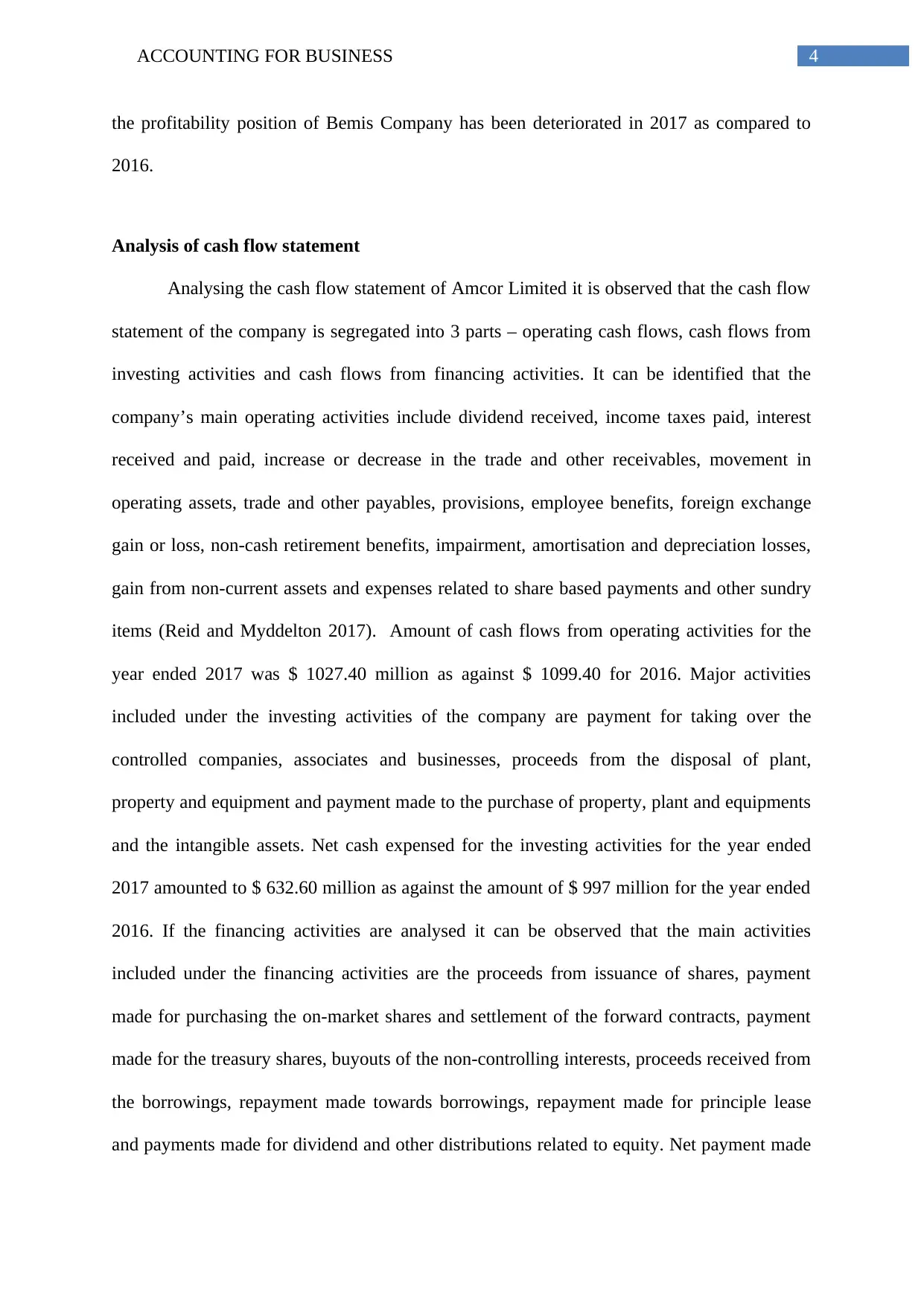
4ACCOUNTING FOR BUSINESS
the profitability position of Bemis Company has been deteriorated in 2017 as compared to
2016.
Analysis of cash flow statement
Analysing the cash flow statement of Amcor Limited it is observed that the cash flow
statement of the company is segregated into 3 parts – operating cash flows, cash flows from
investing activities and cash flows from financing activities. It can be identified that the
company’s main operating activities include dividend received, income taxes paid, interest
received and paid, increase or decrease in the trade and other receivables, movement in
operating assets, trade and other payables, provisions, employee benefits, foreign exchange
gain or loss, non-cash retirement benefits, impairment, amortisation and depreciation losses,
gain from non-current assets and expenses related to share based payments and other sundry
items (Reid and Myddelton 2017). Amount of cash flows from operating activities for the
year ended 2017 was $ 1027.40 million as against $ 1099.40 for 2016. Major activities
included under the investing activities of the company are payment for taking over the
controlled companies, associates and businesses, proceeds from the disposal of plant,
property and equipment and payment made to the purchase of property, plant and equipments
and the intangible assets. Net cash expensed for the investing activities for the year ended
2017 amounted to $ 632.60 million as against the amount of $ 997 million for the year ended
2016. If the financing activities are analysed it can be observed that the main activities
included under the financing activities are the proceeds from issuance of shares, payment
made for purchasing the on-market shares and settlement of the forward contracts, payment
made for the treasury shares, buyouts of the non-controlling interests, proceeds received from
the borrowings, repayment made towards borrowings, repayment made for principle lease
and payments made for dividend and other distributions related to equity. Net payment made
the profitability position of Bemis Company has been deteriorated in 2017 as compared to
2016.
Analysis of cash flow statement
Analysing the cash flow statement of Amcor Limited it is observed that the cash flow
statement of the company is segregated into 3 parts – operating cash flows, cash flows from
investing activities and cash flows from financing activities. It can be identified that the
company’s main operating activities include dividend received, income taxes paid, interest
received and paid, increase or decrease in the trade and other receivables, movement in
operating assets, trade and other payables, provisions, employee benefits, foreign exchange
gain or loss, non-cash retirement benefits, impairment, amortisation and depreciation losses,
gain from non-current assets and expenses related to share based payments and other sundry
items (Reid and Myddelton 2017). Amount of cash flows from operating activities for the
year ended 2017 was $ 1027.40 million as against $ 1099.40 for 2016. Major activities
included under the investing activities of the company are payment for taking over the
controlled companies, associates and businesses, proceeds from the disposal of plant,
property and equipment and payment made to the purchase of property, plant and equipments
and the intangible assets. Net cash expensed for the investing activities for the year ended
2017 amounted to $ 632.60 million as against the amount of $ 997 million for the year ended
2016. If the financing activities are analysed it can be observed that the main activities
included under the financing activities are the proceeds from issuance of shares, payment
made for purchasing the on-market shares and settlement of the forward contracts, payment
made for the treasury shares, buyouts of the non-controlling interests, proceeds received from
the borrowings, repayment made towards borrowings, repayment made for principle lease
and payments made for dividend and other distributions related to equity. Net payment made
Paraphrase This Document
Need a fresh take? Get an instant paraphrase of this document with our AI Paraphraser
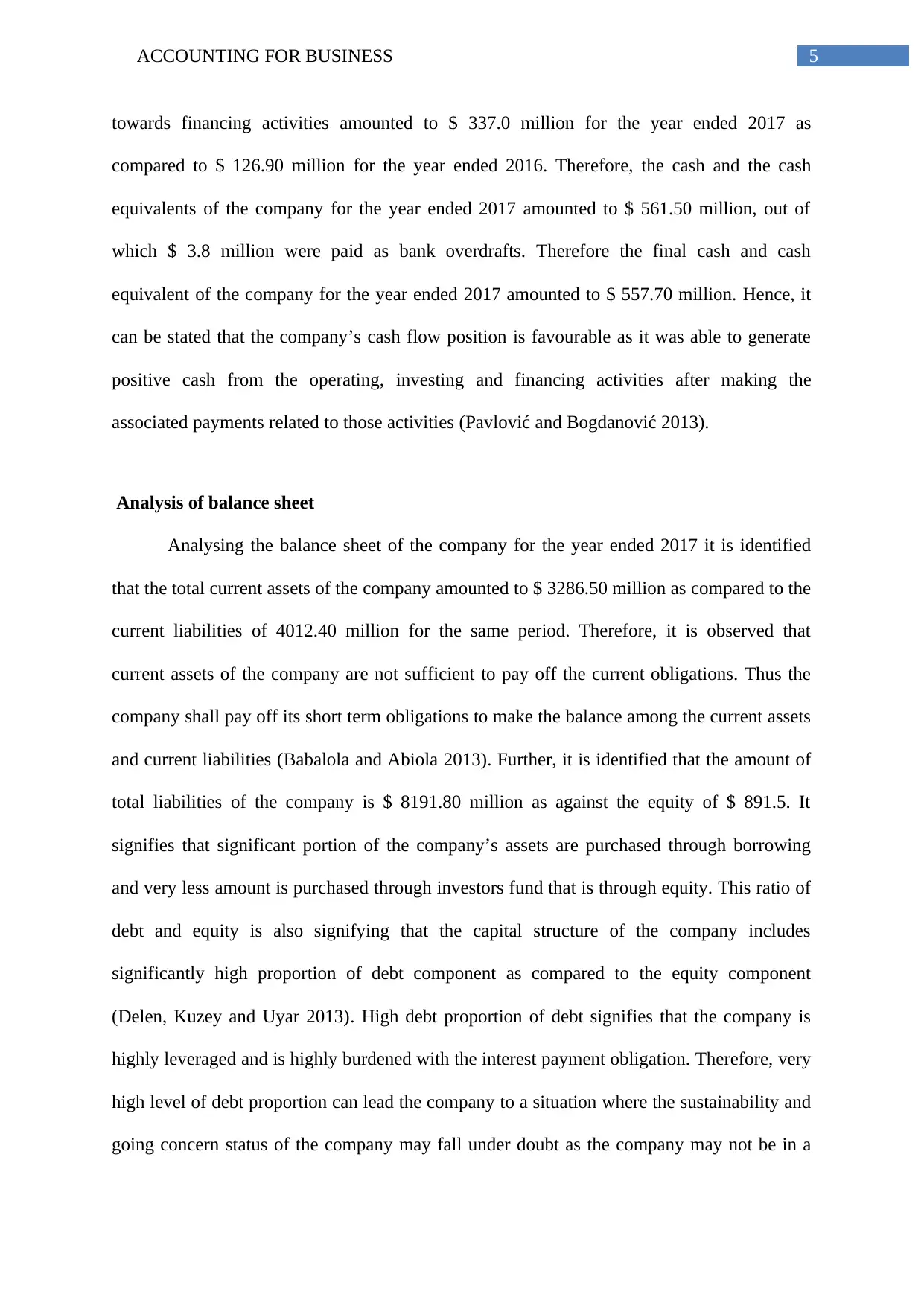
5ACCOUNTING FOR BUSINESS
towards financing activities amounted to $ 337.0 million for the year ended 2017 as
compared to $ 126.90 million for the year ended 2016. Therefore, the cash and the cash
equivalents of the company for the year ended 2017 amounted to $ 561.50 million, out of
which $ 3.8 million were paid as bank overdrafts. Therefore the final cash and cash
equivalent of the company for the year ended 2017 amounted to $ 557.70 million. Hence, it
can be stated that the company’s cash flow position is favourable as it was able to generate
positive cash from the operating, investing and financing activities after making the
associated payments related to those activities (Pavlović and Bogdanović 2013).
Analysis of balance sheet
Analysing the balance sheet of the company for the year ended 2017 it is identified
that the total current assets of the company amounted to $ 3286.50 million as compared to the
current liabilities of 4012.40 million for the same period. Therefore, it is observed that
current assets of the company are not sufficient to pay off the current obligations. Thus the
company shall pay off its short term obligations to make the balance among the current assets
and current liabilities (Babalola and Abiola 2013). Further, it is identified that the amount of
total liabilities of the company is $ 8191.80 million as against the equity of $ 891.5. It
signifies that significant portion of the company’s assets are purchased through borrowing
and very less amount is purchased through investors fund that is through equity. This ratio of
debt and equity is also signifying that the capital structure of the company includes
significantly high proportion of debt component as compared to the equity component
(Delen, Kuzey and Uyar 2013). High debt proportion of debt signifies that the company is
highly leveraged and is highly burdened with the interest payment obligation. Therefore, very
high level of debt proportion can lead the company to a situation where the sustainability and
going concern status of the company may fall under doubt as the company may not be in a
towards financing activities amounted to $ 337.0 million for the year ended 2017 as
compared to $ 126.90 million for the year ended 2016. Therefore, the cash and the cash
equivalents of the company for the year ended 2017 amounted to $ 561.50 million, out of
which $ 3.8 million were paid as bank overdrafts. Therefore the final cash and cash
equivalent of the company for the year ended 2017 amounted to $ 557.70 million. Hence, it
can be stated that the company’s cash flow position is favourable as it was able to generate
positive cash from the operating, investing and financing activities after making the
associated payments related to those activities (Pavlović and Bogdanović 2013).
Analysis of balance sheet
Analysing the balance sheet of the company for the year ended 2017 it is identified
that the total current assets of the company amounted to $ 3286.50 million as compared to the
current liabilities of 4012.40 million for the same period. Therefore, it is observed that
current assets of the company are not sufficient to pay off the current obligations. Thus the
company shall pay off its short term obligations to make the balance among the current assets
and current liabilities (Babalola and Abiola 2013). Further, it is identified that the amount of
total liabilities of the company is $ 8191.80 million as against the equity of $ 891.5. It
signifies that significant portion of the company’s assets are purchased through borrowing
and very less amount is purchased through investors fund that is through equity. This ratio of
debt and equity is also signifying that the capital structure of the company includes
significantly high proportion of debt component as compared to the equity component
(Delen, Kuzey and Uyar 2013). High debt proportion of debt signifies that the company is
highly leveraged and is highly burdened with the interest payment obligation. Therefore, very
high level of debt proportion can lead the company to a situation where the sustainability and
going concern status of the company may fall under doubt as the company may not be in a

6ACCOUNTING FOR BUSINESS
position to pay off the claims of the lenders (Klettner, Clarke and Boersma 2014). Hence, it is
suggested that Amcor Limited shall pay off its borrowing and for further requirement of
additional fund it shall raise it through equity rather than obtaining through borrowings.
position to pay off the claims of the lenders (Klettner, Clarke and Boersma 2014). Hence, it is
suggested that Amcor Limited shall pay off its borrowing and for further requirement of
additional fund it shall raise it through equity rather than obtaining through borrowings.
⊘ This is a preview!⊘
Do you want full access?
Subscribe today to unlock all pages.

Trusted by 1+ million students worldwide
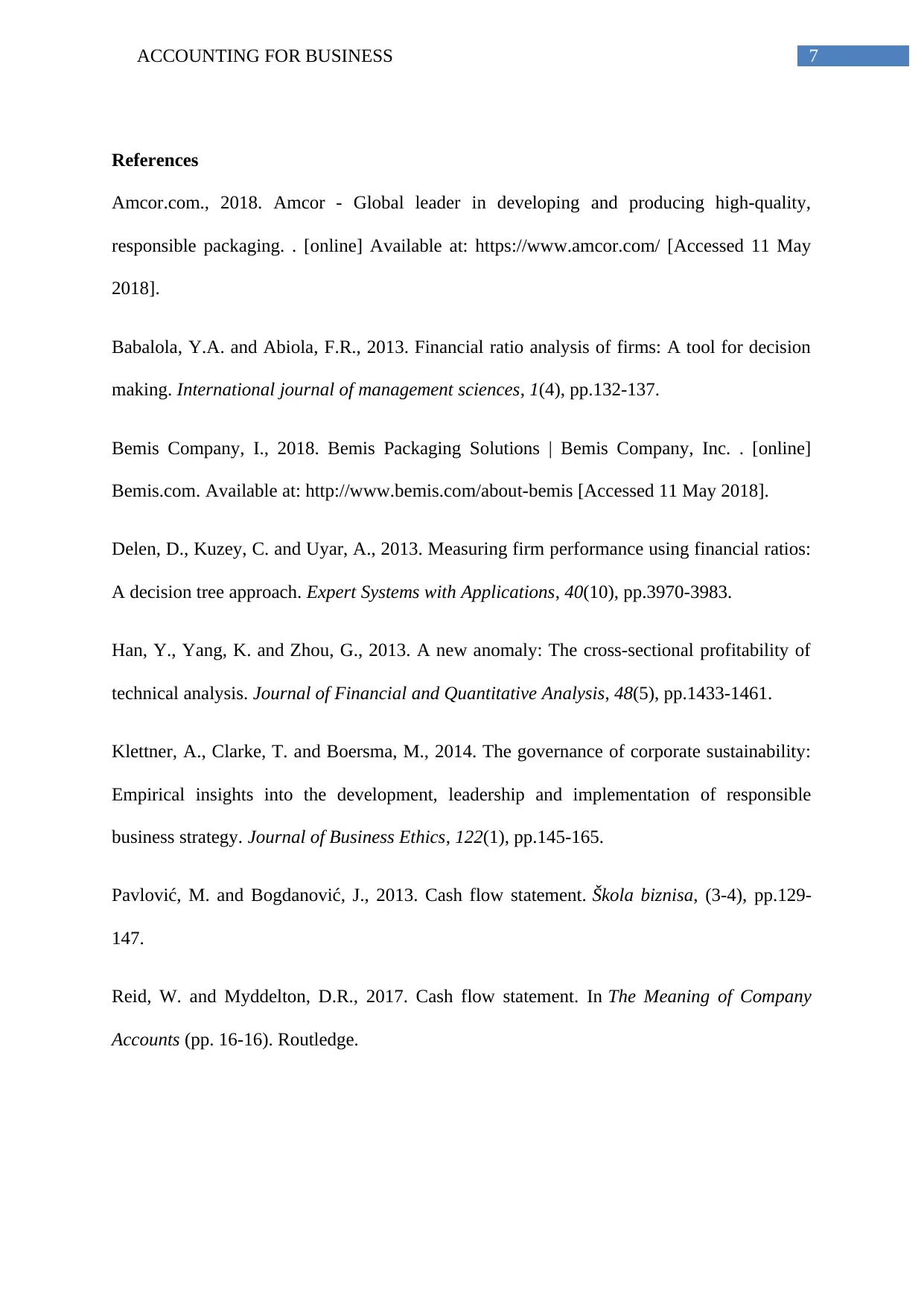
7ACCOUNTING FOR BUSINESS
References
Amcor.com., 2018. Amcor - Global leader in developing and producing high-quality,
responsible packaging. . [online] Available at: https://www.amcor.com/ [Accessed 11 May
2018].
Babalola, Y.A. and Abiola, F.R., 2013. Financial ratio analysis of firms: A tool for decision
making. International journal of management sciences, 1(4), pp.132-137.
Bemis Company, I., 2018. Bemis Packaging Solutions | Bemis Company, Inc. . [online]
Bemis.com. Available at: http://www.bemis.com/about-bemis [Accessed 11 May 2018].
Delen, D., Kuzey, C. and Uyar, A., 2013. Measuring firm performance using financial ratios:
A decision tree approach. Expert Systems with Applications, 40(10), pp.3970-3983.
Han, Y., Yang, K. and Zhou, G., 2013. A new anomaly: The cross-sectional profitability of
technical analysis. Journal of Financial and Quantitative Analysis, 48(5), pp.1433-1461.
Klettner, A., Clarke, T. and Boersma, M., 2014. The governance of corporate sustainability:
Empirical insights into the development, leadership and implementation of responsible
business strategy. Journal of Business Ethics, 122(1), pp.145-165.
Pavlović, M. and Bogdanović, J., 2013. Cash flow statement. Škola biznisa, (3-4), pp.129-
147.
Reid, W. and Myddelton, D.R., 2017. Cash flow statement. In The Meaning of Company
Accounts (pp. 16-16). Routledge.
References
Amcor.com., 2018. Amcor - Global leader in developing and producing high-quality,
responsible packaging. . [online] Available at: https://www.amcor.com/ [Accessed 11 May
2018].
Babalola, Y.A. and Abiola, F.R., 2013. Financial ratio analysis of firms: A tool for decision
making. International journal of management sciences, 1(4), pp.132-137.
Bemis Company, I., 2018. Bemis Packaging Solutions | Bemis Company, Inc. . [online]
Bemis.com. Available at: http://www.bemis.com/about-bemis [Accessed 11 May 2018].
Delen, D., Kuzey, C. and Uyar, A., 2013. Measuring firm performance using financial ratios:
A decision tree approach. Expert Systems with Applications, 40(10), pp.3970-3983.
Han, Y., Yang, K. and Zhou, G., 2013. A new anomaly: The cross-sectional profitability of
technical analysis. Journal of Financial and Quantitative Analysis, 48(5), pp.1433-1461.
Klettner, A., Clarke, T. and Boersma, M., 2014. The governance of corporate sustainability:
Empirical insights into the development, leadership and implementation of responsible
business strategy. Journal of Business Ethics, 122(1), pp.145-165.
Pavlović, M. and Bogdanović, J., 2013. Cash flow statement. Škola biznisa, (3-4), pp.129-
147.
Reid, W. and Myddelton, D.R., 2017. Cash flow statement. In The Meaning of Company
Accounts (pp. 16-16). Routledge.
1 out of 7
Related Documents
Your All-in-One AI-Powered Toolkit for Academic Success.
+13062052269
info@desklib.com
Available 24*7 on WhatsApp / Email
![[object Object]](/_next/static/media/star-bottom.7253800d.svg)
Unlock your academic potential
Copyright © 2020–2025 A2Z Services. All Rights Reserved. Developed and managed by ZUCOL.





